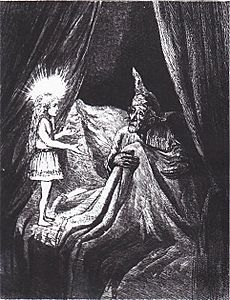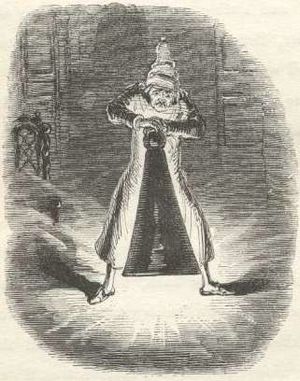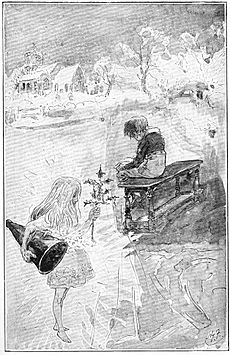Ghost of Christmas Past facts for kids
The Ghost of Christmas Past is a make-believe character from Charles Dickens' famous 1843 story, A Christmas Carol. This Ghost is one of three special spirits who visit a very grumpy and greedy man named Ebenezer Scrooge. Their goal is to give him a chance to change his ways and become a better person.
The Spirit looks both young and old at the same time. A bright light shines from the top of its head. It carries a large cap that looks like a candle snuffer under its arm. The Ghost of Christmas Past arrives in Scrooge's bedroom when the clock strikes one. Each of the Christmas Ghosts shows Scrooge a different time in his life. This first Ghost focuses on Christmases from Scrooge's past, both recent and long ago. The events from the past "are just shadows," and the bright light from the Spirit helps Scrooge see his old memories clearly.
Contents
Why the Story Was Written

In 1843, Charles Dickens was very worried about how poor people were treated. He was especially upset about poor children. He had seen kids working in terrible conditions in a tin mine. He also visited a school for very poor children. Dickens himself had been poor as a boy. He had to work in a factory because his father was sent to prison for not paying his debts.
At first, Dickens wanted to write a political leaflet. It was going to be called An Appeal to the People of England, on behalf of the Poor Man's Child. But he changed his mind. Instead, he wrote A Christmas Carol. This story shared his concerns about poverty and unfairness in society.
Dickens's friend, John Forster, said that Dickens "liked ghosts." Even though Dickens didn't really believe in them, his magazines often featured ghost stories. He even published a new ghost story every year for some time after A Christmas Carol. In this famous story, Dickens made the idea of ghosts feel like a natural part of the real world.
The Ghost's Role in the Story
The Ghost of Christmas Past is a strange, magical creature. It shimmers and flickers like a candle flame. Its look constantly changes as it shows Scrooge different memories. When one memory becomes clear, another one fades away. The Spirit represents Scrooge's younger days, so it can look youthful. Its skin seems to have the "tenderest bloom." But because Scrooge is now old, the Spirit can also look old to show this.
The Ghost's clothes are also full of opposites. It holds a branch of holly, which means winter. But its robe is decorated with summer flowers. The way the Spirit constantly changes might also show the many different people Scrooge sees in his visions.
When Scrooge asks the Spirit why it is there, the Ghost answers, "Your welfare!" Scrooge says he would rather just get a good night's sleep. The Spirit then replies, "Your reclamation, then. Take heed!" This means the Ghost is there to help Scrooge become a better person.
Visions of Scrooge's Past

Even though the Spirit seems gentle and light, it is surprisingly strong. It takes Scrooge's arm and tells him, "Rise! and walk with me!" Scrooge tries to ignore the sad memories of his childhood that the Spirit shows him. But he starts to show emotion when he sees his younger sister, Fan, again.
Scrooge becomes even more lively when he sees the Christmas Eve celebrations from his time as an apprentice for Mr. Fezziwig. Scrooge shows more of his human side when the Spirit asks him about Fezziwig:
"A small matter," said the Ghost, "to make these silly folks so full of gratitude."
The Spirit told him to listen to the two apprentices. They were praising Fezziwig with all their hearts. When Scrooge had listened, the Spirit said,
"Why! Is it not? He has spent but a few pounds of your mortal money: three or four perhaps. Is that so much that he deserves this praise?"
"It isn’t that," said Scrooge. He was getting heated by the comment and spoke like his younger self. "It isn’t that, Spirit. He has the power to make us happy or unhappy. To make our work easy or hard. A pleasure or a chore. Say that his power is in words and looks. In things so small and unimportant that it is impossible to add and count them up: what then? The happiness he gives is just as great as if it cost a fortune."
He felt the Spirit’s look and stopped.
Scrooge is given a chance to think about how good and kind an employer Fezziwig was. He starts to regret how badly he treats his own clerk, Bob Cratchit.
The Spirit then shows Scrooge when he was engaged to the love of his life, Belle. It also shows their painful breakup. When Scrooge gets upset by these memories, the Spirit says, "These are the shadows of the things that have been. That they are what they are, do not blame me."
Scrooge becomes very distressed. He cries out, "Leave me! Take me back. Haunt me no longer!" He grabs the Spirit's cap. "In the struggle... Scrooge saw that its light was burning high and bright. He felt that this light was connected to the Spirit's power over him. So, he grabbed the snuffer-cap and quickly pressed it down upon its head."
Who Has Played the Ghost?
Dickens calls the Spirit "it." This means the Ghost is neither male nor female. This has been a challenge for plays, TV shows, and movies. The Ghost has been played by men and women, and by both young and old actors.
In Movies
- Marie Ney - Scrooge (1935)
- Ann Rutherford - A Christmas Carol (1938)
- Michael J. Dolan - Scrooge (1951)
- Edith Evans - Scrooge (1970)
- Diana Quick (voice) - A Christmas Carol (1971)
- David Johansen - Scrooged (1988)
- Jessica Fox (voice) - The Muppet Christmas Carol (1992)
- Jane Horrocks - Christmas Carol: The Movie (2001)
- Jim Carrey (voice) - A Christmas Carol (2009)
- Sunita Mani - Spirited (2022)
On Television
- Joan Gardner (voice) - Mister Magoo's Christmas Carol (1962)
- Angela Pleasence - A Christmas Carol (1984)
- Joel Grey - A Christmas Carol (1999)
- Matt Smith - Doctor Who episode A Christmas Carol (2010)
- Ashleigh Ball - My Little Pony: Friendship Is Magic episode A Hearth's Warming Tail (2016)
- Andy Serkis - A Christmas Carol (2019)
In Plays
- Patrick Stewart - A Christmas Carol (1988)
- Jaime Lyn Beatty - A VHS Christmas Carol (2020)
See also
 In Spanish: Fantasma de las Navidades Pasadas para niños
In Spanish: Fantasma de las Navidades Pasadas para niños



